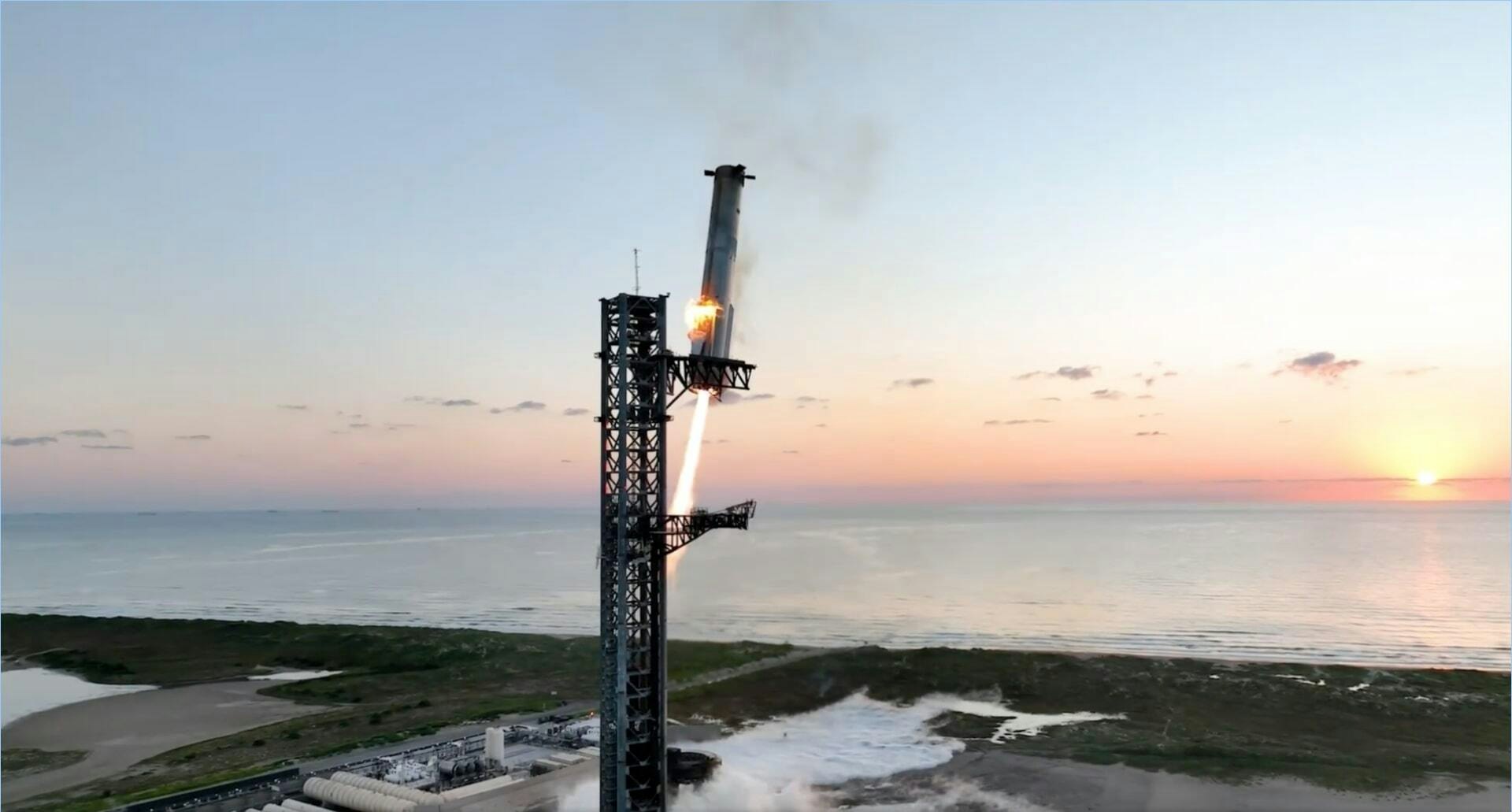
SpaceX just massively leveled up its rocket booster recovery game.
The most exciting moment in the fifth test flight of SpaceX’s Starship wasn’t about Starship at all. Instead, the Super Heavy rocket stole the show by successfully landing back at the launch tower just a few minutes after blasting off. Starship itself hovered briefly over its target in the Indian Ocean before toppling over. NASA’s schedule for the Artemis program — in which Starship is slated to carry the Artemis 3 crew to the Moon in 2026 — depends on SpaceX getting this whole system right and on time.

Sticking the Landing
Seven minutes after liftoff, SpaceX’s 200-foot-tall, 30-foot-wide Super Heavy rocket ended up right back where it started. After releasing Starship, the massive first-stage booster fired 13 of its 33 Raptor engines to slow its fall back toward Earth and steer itself into position over the launch tower. Next, just 3 of those 33 engines delicately maneuvered the several-hundred-thousand-ton rocket into the narrow space between two gargantuan mechanical arms, then hovered there while the arms closed around it like pincers, holding Super Heavy in place.
SpaceX calls those huge mechanical arms the “chopsticks,” and they make up part of a launch tower called Mechazilla, built especially for Super Heavy. Before rocket launches, the arms lift and stack rocket stages and payloads. And after launch, it turns out, they can catch a returning rocket in midair, but only if it’s in exactly the right position.
Both the rocket and the pad had to meet more than a thousand criteria before this weekend’s landing attempt — otherwise Super Heavy would have splashed down in the Gulf of Mexico. If something had gone wrong, SpaceX stood to lose not just the rocket, but its enormous launch tower.
The goal, according to SpaceX, is eventually to refuel a freshly-returned Super Heavy on the launch pad, then send that same rocket back to space half an hour later. SpaceX has done well at recovering and re-using rocket stages over the last several years, but its still a long way off from its goals. Its Falcon 9 boosters have touched down on landing pads or floating barges several hundred times (although it doesn’t always work out), and re-using the first stage rockets has become almost routine; last year, one Falcon 9 made 16 flights.
What About Starship?
Meanwhile, the Starship vehicle stuck its own landing — at least in the sense that it did what SpaceX engineers wanted it to do, namely reach space, survive re-entry through Earth’s atmosphere, and then maneuver to a particular spot in the Indian Ocean. The vehicle even managed to hover over that spot, balanced on three of its 6 engines for a few minutes before falling over and blowing up. Which SpaceX insists was the plan all along.
“We were not intending to recover any of Starship, so that was the best ending that we could have hoped for,” Kate Tice, manager of Quality Systems Engineering at SpaceX, said in comments during the test flight on Sunday.
The flight came just four flights, and 18 months, after Starship’s first test flight, which saw the vehicle explode over the Gulf of Mexico just minutes after takeoff; the second test flight in March 2024 also ended in a fireball. On the most recent flight, in June, Starship lost a large number of the hexagonal tiles that make up its heat shield, which is supposed to protect the vehicle from the tremendous heat of re-entry. One wing appeared badly damaged in video from onboard cameras.
“The forward flaps were so melted it was like trying to control it with little skeleton hands,” Musk told CNN in an interview at the time. Since June, SpaceX engineers and technicians have revamped Starship’s heat shield, essentially adding sturdier tiles, an extra layer of protective material, and some additional shielding for the flaps.
Regulatory Woes and Deadlines
That reworking contributed to delays that kept the fifth flight from getting off the ground sooner; the FAA had to review the changes to the ship and the flight before issuing a permit. The FAA also had to consider the environmental impact of the launch — something that’s been an issue since SpaceX built its facility near Boca Chica, Texas — a concern which the company publicly called “superfluous” in a recent blog post.
Last month, Musk declared on X (formally Twitter; which he also owns) that the company plans to sue the U.S. Federal Aviation Administration (FAA). The FAA slapped SpaceX with a $630,000 fine for breaking regulations during two summer 2023 launches from its facilities in Florida. In one case, SpaceX launched a flight using a control room — and a modified countdown procedure — that the FAA hadn’t yet reviewed and approved. And in the other case, SpaceX launched with rocket fuel from a production facility that also hadn’t been approved. According to the FAA, those regulations exist to make sure that the people blasting explosive-laden rockets over U.S. airspace are doing so as safely as possible (at least for the people on the ground).
SpaceX is under definite pressure to get Starship and Super Heavy underway fast. Starship is supposed to land the first humans since 1972 on the Moon in 2026, and if the ship isn’t ready on time, that could push back the whole timeline for the Artemis program. NASA has already signed a $2.8 billion contract with SpaceX for the project — which puts the FAA’s fine in perspective.







